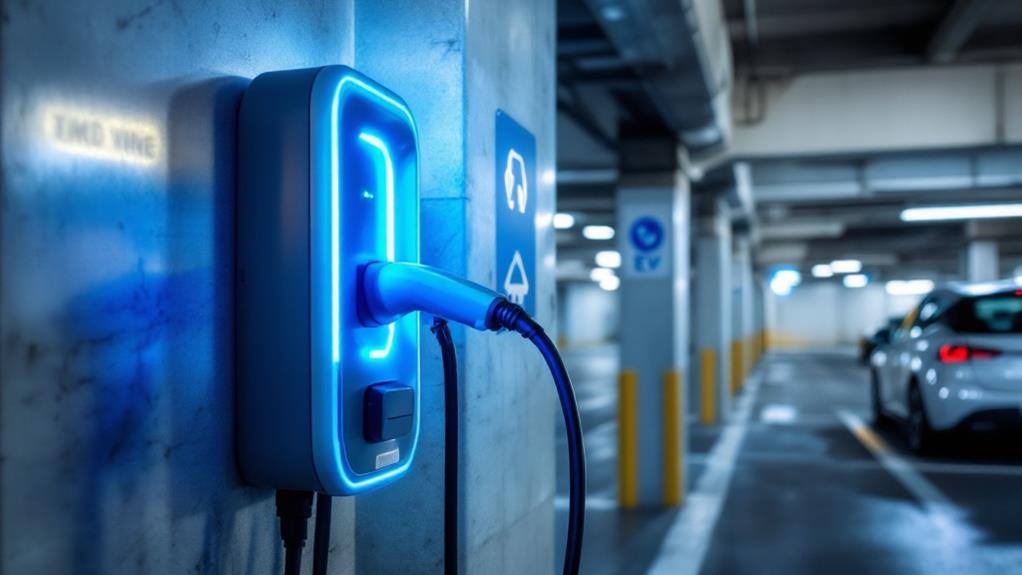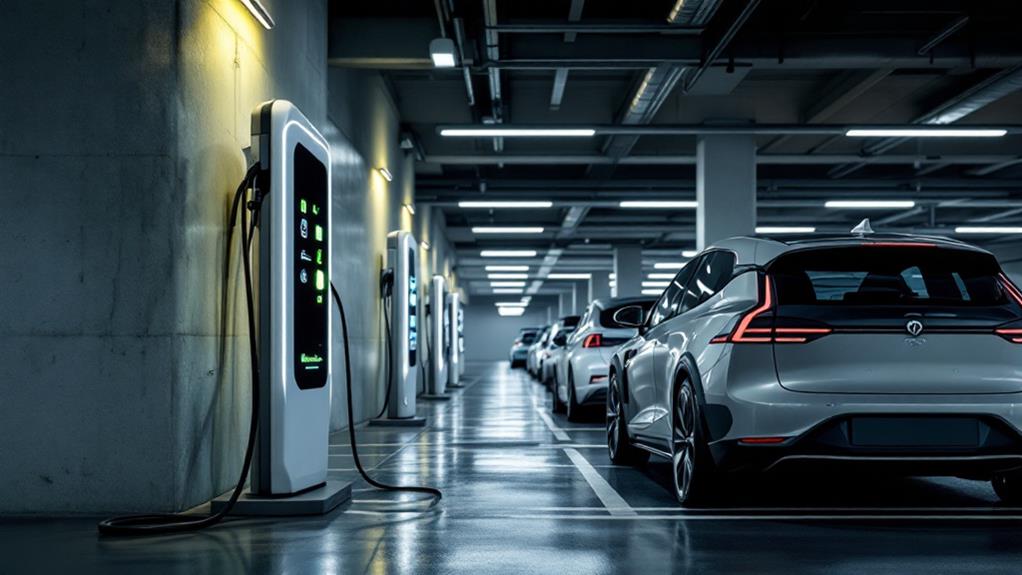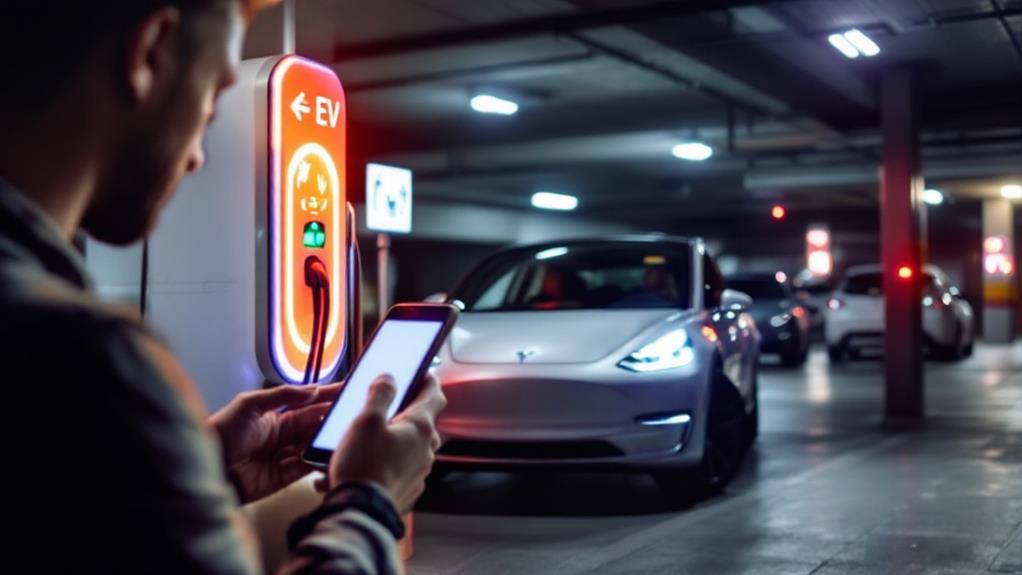How to Find Electric Vehicle Charging Stations in Public Garages

To find EV charging stations in public garages, start by using dedicated apps like PlugShare or ChargeHub. You can also search online with keywords like "EV charging" plus the garage or city name. Check garage websites for information on their charging facilities. Plan ahead by verifying station types, connector compatibility, and real-time availability. Look for clear signage or designated EV spaces when you arrive. Be aware of payment options, costs, and any time limits. Remember to follow charging etiquette, such as moving your vehicle once it's charged. By securing these strategies, you'll guarantee a more effortless charging experience on your travels.
Locating Charging Stations
In light of the growing popularity of electric vehicles, finding charging stations in public parking garages has become much easier. You now have several options to locate electric vehicle charging stations in urban areas and beyond.
One of the most efficient ways to find charging spots is by using dedicated websites and mobile apps. Platforms like PlugShare, ChargeHub, and the U.S. Department of Energy's Alternative Fuels Data Center offer thorough databases of EV charging locations. These tools often provide real-time information on station availability and occupancy status, saving you time and frustration.
If you're looking for a specific garage, try searching online using keywords like "electric vehicle charging" or "EV charging" along with the city or garage name. Many garage owners and operators list their charging station locations, connector types, and pricing information on their websites or signage.
For a more direct approach, you can check the websites of public parking garages in your area. They often provide detailed information about their EV charging facilities, including the number of stations available and any special instructions for use. This method guarantees you have the most up-to-date and accurate information straight from the source.
Understanding Station Types
Pertaining to charging station types, you'll find a variety of options in public parking garages. These facilities may offer Level 1, Level 2, or DC fast charging stations to accommodate different electric vehicle needs. Each type has its own characteristics and charging speeds.
Level 1 charging stations operate on 120V and provide the slowest charge rate, typically adding 3-5 miles of range per hour. Level 2 stations use 240V and can charge your vehicle at 15-30 miles per hour, making them a more practical option for longer parking stays. If you're in a hurry, DC fast charging stations are your best bet, capable of providing 60-200 miles of range in just 15-30 minutes. However, these are usually the most expensive option.
The availability of charging stations in a public garage depends on factors like electrical capacity, demand, and cost considerations. Before visiting a parking facility, it's important to check the charging station specifications, pricing, and availability. This allows you to efficiently charge your electric vehicle and avoid any inconvenience. Remember that not all garages offer all types of charging stations, so planning ahead is essential.
Assessing Compatibility and Availability

When looking for charging stations in public parking garages, it's essential to assess both compatibility and availability. Before you head out, check the connector types offered at the garage's EV charging stations to guarantee they're compatible with your vehicle. Different EVs use various connector types, so this step can save you time and frustration.
To streamline your search for available charging spots, take advantage of mobile apps that provide real-time information on station occupancy. These apps can help you plan your trip more effectively and avoid arriving at a fully occupied charging area.
Keep in mind that some garages implement strategies to manage EV charging station usage. You might encounter reserved spots or time limits on charging sessions. It's wise to familiarize yourself with these policies beforehand to avoid any surprises.
Lastly, don't forget to review the pricing details for both parking and charging. Rates can vary substantially between garages, so understanding the costs in advance will help you make informed decisions. By considering compatibility, availability, usage policies, and pricing, you'll be better prepared to leverage EV charging stations in public garages efficiently.
Payment Options and Costs
Public charging stations typically offer a variety of payment options to accommodate different user preferences. You'll find that most stations accept credit or debit cards, mobile apps, and RFID cards for your convenience. When using a network like Electrify America, you can often streamline the payment process through their dedicated app.
Be aware that charging costs can vary considerably depending on the location. Some stations provide free charging, while others charge based on time or energy consumed. You might encounter stations that offer complimentary charging for a set period, after which they'll apply an hourly or per-kWh rate.
To help you plan your expenses, many charging stations display real-time pricing and billing information on-site or through mobile apps. This transparency allows you to make informed decisions about when and where to charge your vehicle.
Keep in mind that some stations may impose additional fees, such as idle charges if you leave your car plugged in after it's fully charged. To avoid unexpected costs, always check the station's terms and conditions before initiating a charging session. By staying informed about payment options and potential fees, you can effectively manage your electric vehicle charging expenses.
Navigating to Charging Spots

Charging-spot guidance can be an indispensable skill for electric vehicle owners. As the United States moves away from internal combustion engines, more public garages are offering designated EV charging spots. To find these stations, you'll need to employ a combination of technology and observational skills.
Start by using EV navigation apps like PlugShare or ChargePoint. These tools provide real-time information on charging station locations and availability in public garages. Many garage operators have integrated their charging stations into these networks, allowing you to locate and pay for charging through the apps.
When you arrive at the garage, look for signs or directories indicating EV charging spots. They're often marked with distinct signage or as EV-only parking spaces. Don't assume they'll be in the most visible areas; sometimes, they're tucked away in less prominent locations.
If you're visiting during peak hours, arrive early and scout the garage. This strategy gives you a better chance of securing an available charging spot. Remember, as EV adoption grows, competition for these spaces may increase, so planning ahead is pivotal.
Charging Etiquette and Best Practices
Once you've successfully located a charging spot, it's important to follow proper etiquette and best practices. First, only park in a charging spot if you're actively charging your vehicle. Don't use these spaces as regular parking spots, as this prevents other EV drivers from accessing the charger.
When you arrive, check if there's a queue system in place. Some stations use apps or physical queues to manage charging order. If there isn't a system, communicate with other drivers to determine who's next in line.
While charging, be mindful of your time. Many public chargers have time limits, so move your vehicle once you've finished or reached the maximum allowed time. This guarantees fair access for all EV owners.
Keep the charging area clean and tidy. Don't leave trash or charging cables on the ground. If you notice any issues with the charger, report them to the station operator or through the appropriate app.
Lastly, stay informed about local Fuels Data. This information can help you understand charging costs, peak usage times, and availability trends, allowing you to plan your charging sessions more efficiently.



